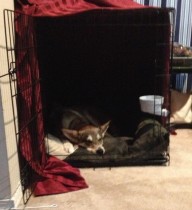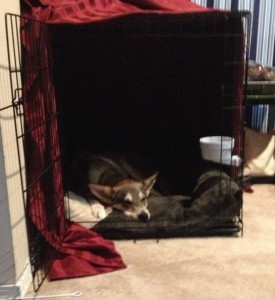I recently spoke to someone over the phone about their potty training issues. She mentioned that another trainer had recommended getting a kennel for her 4 month old puppy to help with potty training and she didn’t want to do that. I explained to her that it was only temporary and that if it was introduced correctly, it would make potty training a breeze!
I got my dog, Loker, when he was 2 years old from an animal shelter that had him since he was 12 weeks old. This wonderful no-kill shelter keeps dogs (and cats) until they are adopted. They have crates for the dogs indoors and large dog runs outside. It really is as home-like a shelter can get. Needless to say, he came to me crate trained already so it made it very easy for me to introduce him to my home without any potty accidents.
That is a wonderful example of why crates are great! Not only are they a great way of controlling what your dog has access to when you are not home, but they can be lifesavers if you ever decide to travel with your dog, board your dog in someone else’s home, or if they ever need to stay at a vets office. Your dog should know that being contained does not mean the world is coming to an end. When introduced correctly, the dog should actually LOVE their crate.
Brief overview of teaching your dog to love his crate:
- Make sure the crate is large enough. It should be big enough for them to stand up, turn around, and lay down without much trouble. Also, make sure it isn’t too large, especially for puppies.
- Throw some delicious treats in there so the dog walks in on his own. Do this at the beginning, but also continue to reward your dog for going in there when asked. Never force your dog in there, just give him time and keep dropping treats near and just inside the crate.
- Feed your dog his meals in his crate. This will help him learn that all good things happen in the crate. Also, this will help prevent any resource guarding issues.
- Leave chew-able toys in the crate so the dog has something to do.
- In the beginning, don’t leave them in there too long.
Check out this article that the HSUS wrote on proper crate training with detailed steps: Crate Training

